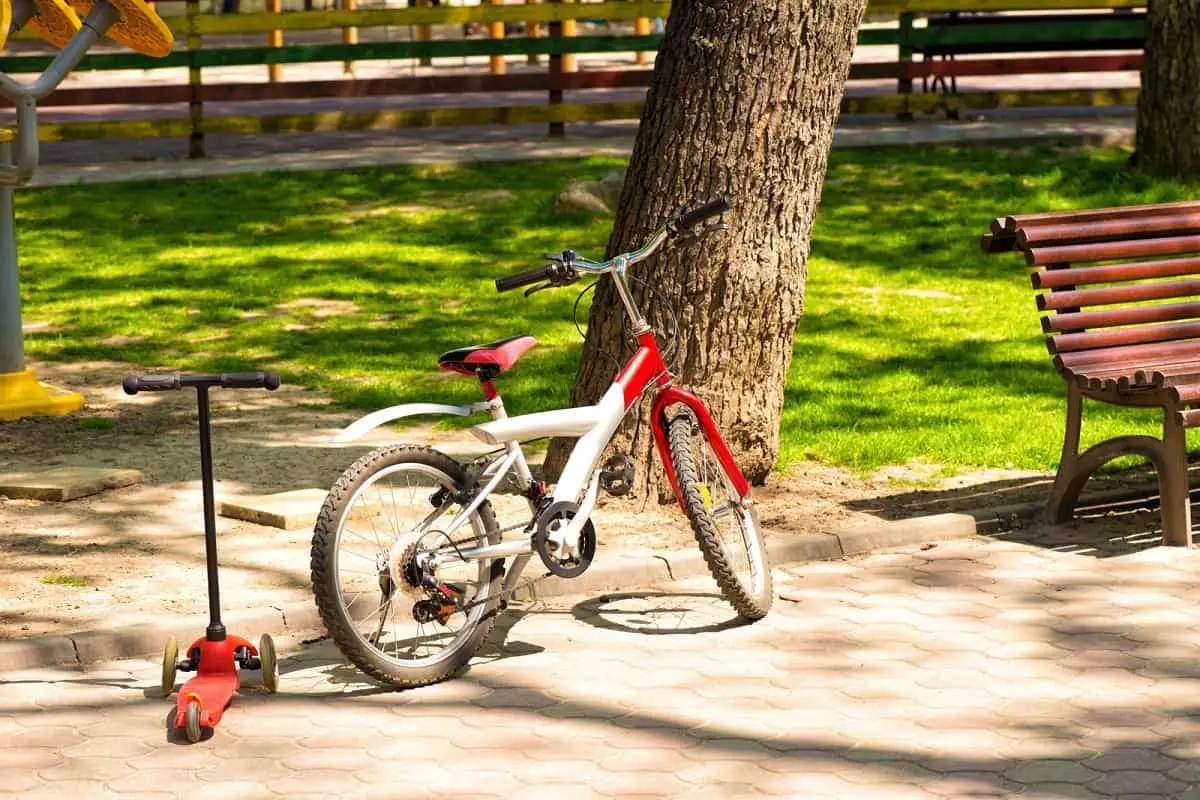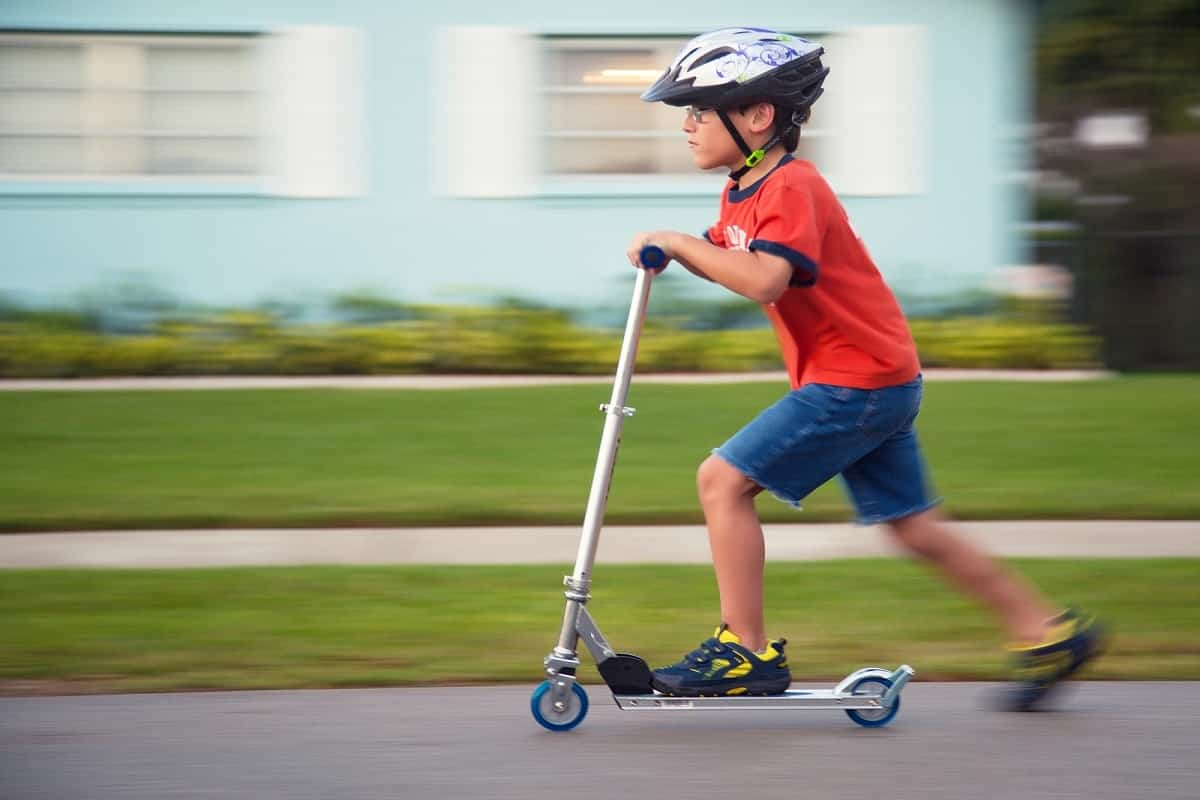Scooter Helmet Vs Bike Helmet
When someone says that you can wear a bicycle helmet on your scooter, they may be right or they may be wrong, depending on your scooter.
Let’s take a look at a scooter helmet Vs bike helmet to see exactly which helmet can be used for which activity.
KEY TAKEAWAYS
* A helmet for a kick scooter and a bicycle helmet are the same and must have CPSC certification.
* The helmet should fit snugly and securely if it is to provide proper protection.
* Helmet rules for kick scooters are not the same as for e-scooters or mopeds.

Disclosure: As an Amazon Associate, we earn from qualifying purchases. Disclosure Statement.
Page Content
Scooter Helmet Vs Bike Helmet
The main difference between a scooter helmet Vs bike helmet is nothing, providing we’re talking about kick scooters. Electric scooters and moped type scooters are a different story though.
In a kick scooter helmet Vs bike helmet situation, you are dealing with the same items. Scootering and biking may be different in practice, however, they have the same safety requirements when it comes to protecting your skull.
Both a bike helmet and a scooter helmet are designed to protect the same areas to the same extent. These are invaluable safety devices that keep your skull safe and are designed to prevent any injuries.
Prevention of Head Injuries
Whether you are on a kick scooter or a bicycle, using a helmet is essential to mitigate potential damage in case of falls or accidents. Even though injuries may still occur, the helmet will give better protection and can prevent serious complications.
Related Article: Do Helmets Prevent Concussions?
Whether you are riding a bike or a kick scooter, your helmet should fit snugly and securely around the top of the head. The helmet should not be so tight that it causes discomfort, but tight enough that it will stay on your head in case of collision.

Comprehensive Protection with Minimal Interference
Helmets for kick scooters and bikes should be large enough to protect the majority of the skull, but they should not be so big as to obstruct the view of the wearer. If a helmet is too bulky or loose, it can interfere with peripheral vision and make it more difficult to see where you are going.
Related Article: How Should A Helmet Fit?
You should always be able to see in front of you and to your left and right when you are wearing a helmet. The helmet should leave around an inch of space between the edge of the helmet and your eyebrows.
Helmets that move around or obstruct your field of vision should be refitted or swapped with one that fits appropriately.
Are Scooter Helmets and Bike Helmets Interchangeable?
When you are shopping for a helmet to use for kick scooter or bike riding the two usually overlap. In most cases, you will find that the same helmets are marketed for both activities.
The CPSC (Consumer Product Safety Commission) recommends that a bike helmet be used for both activities. This will provide appropriate protection when riding a kick scooter or a bicycle, protecting you from head injuries while providing appropriate visibility.
Related Article: Best Scooter Helmets For Toddlers
It is important to note that we are referring to ‘kick’ scooters, not e-scooters! Kick scooters require the rider to use their foot to push or kick the scooter to make it move. E-scooters, otherwise known as Electric Scooters, are battery powered and the use of a bicycle helmet is not recommended.
Video: How to RIDE a SCOOTER!! – (Easy Guide for Beginners)
If you have an e-scooter, you should check our article “Do You Need A Helmet To Ride An Electric Scooter?” for clarification on what you should be wearing to protect your head.
This content was originally published on headsdontbounce.com. If it appears on another website, it is a violation of the copyright owned by headsdontbounce.com.
Safety Certifications for Scooter Helmets and Bike Helmets
Any helmet that you purchase should be clearly and properly labeled as being CPSC certified. Not only is this necessary for the legal sale of the helmet, but it lets you know that it has gone through appropriate testing and has met the safety standard for its intended use.
Any helmet that fails to display these certifications, regardless of whether it is to be used as a bike helmet or a scooter helmet, should not be considered safe.
Related Article: Bike Helmet Safety Standards
Labeling
Any bike or scooter helmet that meets the CPSC standards will have the compliance indicated on its inside liner, an exterior surface, or attached to the chin strap.
Any claims made in other areas do not meet the requirements for any safety certifications, and they should not be considered factual for either bike or scooter helmets.

Testing
Bicycle helmets made after 1999 are required to meet the CPSC standards, and they must be proven to protect against skull fractures and severe head injury when worn properly.
During compliance testing, helmets will be tested for the following, among other things:
- How the helmets perform against impacts and drops
- How temperature and saturation affect the performance of the helmet
- How secure the straps hold the helmet and prevent roll-off
Laboratories are required to keep a record of their testing, and helmets must pass every single test to be certified. Failing in any area is considered a complete failure, and the helmet cannot be marketed as a bicycle helmet.
Applicable Standards
The CPSC maintains federal regulations and standards requirements for bike helmets, which have been applied to all manufactured or imported bicycle helmets since the implementation of the standard in 1999.
The CPSC recommends for activities such as riding a bicycle or kick scooter that a bicycle helmet is worn at all times.
Final Thoughts
A scooter helmet and a bicycle helmet are the same, and you can use the two interchangeably, providing the scooter is a ‘kick’ scooter.
Making sure that the helmet you choose meets CPSC safety certification is one of the best ways to stay safe on a bike or kick scooter.
You may not always have stylish options when shopping for a scooter or bike helmet, but choosing to protect your skull is a choice you will not regret.
I hope we have covered the subject of ‘scooter helmet vs bike helmet’ to your satisfaction. If you enjoyed this article, feel free to leave a comment or question below. Thanks!
If you liked this post, why not share it with your friends.